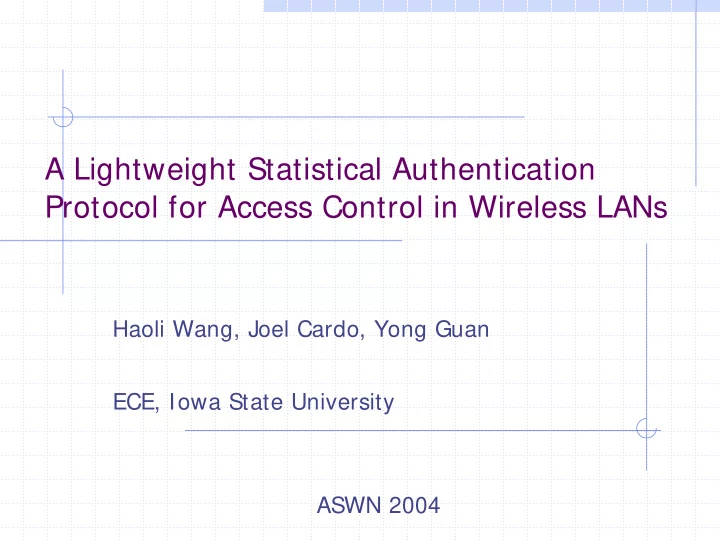

A Lightweight Statistical Authentication Protocol for Access Control in Wireless LANs Haoli Wang, Joel Cardo, Yong Guan ECE, Iowa State University ASWN 2004
Introduction Emergence of visitor networks � Visitor Networks: � LANs that are most often deployed in public places and enable the public network access on an ad-hoc basis. � ISPs desires user authentication before granting the right to access Internet and then charges users accordingly. Traditional authentication protocols for wired networks do not work well in wireless � error-prone wireless transmission medium, node mobility, power conservation constraints � Current wireless authentication protocol, such as WEP, has some security flaws. Dilemma in wireless security Vulnerable wireless networks need strong security protocols, � resulting in enormous power consumption.
Shepherd Overview Design goals � Secure : An attacker should be able to gain the access to the network only with a very low probability. � Robust : The protocol must effectively resist the attacks and the unexpected situations. � Efficient : The protocol must be efficient in term of overhead, bandwidth and CPU cycles. � Detectable : If the attacker tries to gain the access to the network, the protocol will be able to detect it. Characteristics � Lightweight : good for power conservation � Probabilistic method : good for node mobility and error-prone channel
Shepherd How Shepherd works AP and MN generate authentication bit streams by the same random � number generator under the same shared seed as a key. Authentication bit is piggybacked in exchanged frame from MN to AP. � AP determines the legitimacy of MN by continuously checking a series � of randomly generated authentication bits. Unsynchronization Problem Frame loss may cause UnSync problem between AP and MN. � UnSync problem leads to check error at AP. �
Sync Scheme 1 Receiver ’ s pointer always moves forward one step after replying DATA frame. Sender ’ s pointer moves after receiving ACK(+ /-) � ACK+ : move forward one step � ACK- : move forward to “ opposite bit ” + 1 NSI: Non-Synchronization Index + : Loss of ACK frame causes non-sync problem. - : Sender is aware of the checking results.
Sync Scheme 2 Sender ’ s pointer always moves forward one step after sending DATA Receiver ’ s pointer moves after replying DATA frame. � If checking bit correct, move forward one step � If checking bit uncorrected, move forward to “ opposite bit ” + 1 + : Sender is unaware of the checking results. -: Loss of DATA frame causes non-sync problem.
Sync Scheme 3 Sender ’ s pointer always moves forward one step after sending DATA Receiver ’ s pointer moves after replying DATA frame. � If checking bit correct, move forward one step � If checking bit uncorrected, move back to “ opposite bit ” + 1 + : Loss of ACK frame causes non-sync problem. Sender is unaware of the checking results. -: Some bits may be reused.
Statistical Method In scheme 1, The probability of this mobile station H being a legitimate one can be derived by s: number of syncs w: number of checks G: Max number of consecutive frame losses L ACK : ACK frame length
Numerical Analysis Results Scheme 1, BER=10 -4 Scheme 1, BER=10 -5 1 1 Shepherd 0.75 Prob. 5 0 0.75 5 0 0 . 5 0.5 works better 0.25 40 0.25 4 0 0 0 with lower BER. 0 0 w 30 0 0 3 0 2 2 2 2 4 4 s 4 4 20 6 6 2 0 6 6 8 8 8 8 10 10 Scheme 3 , BER=10 -4 1 1 0 0 Scheme 2 , BER=10 -4 Scheme 3 excels among 1 1 3 schemes. 0.75 5 0 0 . 8 5 0 0.5 0.6 0.25 4 0 4 0 0 0.4 0 0 3 0 0 0 30 2 2 2 2 4 4 2 0 4 4 6 6 20 6 6 8 8 8 8 1 1 0 0 10 10
Simulation Results 0.6 1. For a legal node, authentication s1-300KB s2-300KB s4-300KB 0.5 bit error rate increases with s1-1000KB s2-1000KB s4-1000KB increasing BER. 0.4 2. A good scheme is able to ABER 0.3 increase slowly with increasing 0.2 BER. 0.1 3. Scheme 2 increases quickly. 0 Scheme 3 increase slower than 0.00E+00 2.00E-05 4.00E-05 6.00E-05 8.00E-05 1.00E-04 1.20E-04 BER scheme 1. 1 1. For a legal node, Sync rate drops 0.9 s1-1000KB s1-300KB 0.8 s2-1000KB with increasing FLR. s2-300KB s4-1000KB 0.7 s4-300KB 0.6 2. A good scheme is able to drop Sync Rate 0.5 slowly with with increasing FLR. 0.4 0.3 3. Scheme 2 drops quickly. Scheme 0.2 0.1 3 drops slower than scheme 1. 0 0 0.1 0.2 0.3 0.4 0.5 0.6 0.7 0.8 ACKFLR
Comparison Shepherd SOLA RBWA Random bit v v v UnSync v v Problem Algorithm v Workable � RBWA uses the sequence number in each IP packet to avoid sync problem, but we argue that SN is not reliable. � A problem exists in the sync algorithm in SOLA.
Summary A lightweight probabilistic authentication protocol is proposed for wireless networks. � Three synchronization schemes for UnSync Problem. Implementation Consideration � Type and subtype fields are adapted from IEEE 802.11. Reference H. Wang, A. Velayutham and Y. Guan, A Lightwight Authentication Protocol for Acess � Control in IEEE 802.11, IEEE GLOBECOM, 2003 H. Wang, J. Cardo and Y. Guan, Shepherd: A Lightweight Probablistical Authentication � Protocol for Wireless Networks, in submssion.
Thank You
Recommend
More recommend